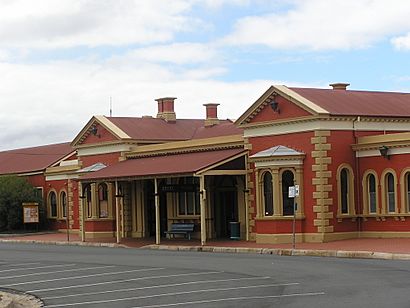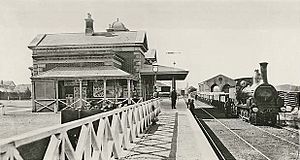Goulburn railway station facts for kids
Quick facts for kids
Goulburn
|
|||||||||||||||||||||||||||||
|---|---|---|---|---|---|---|---|---|---|---|---|---|---|---|---|---|---|---|---|---|---|---|---|---|---|---|---|---|---|

Street front in March 2006
|
|||||||||||||||||||||||||||||
| Location | Sloane Street, Goulburn Australia |
||||||||||||||||||||||||||||
| Coordinates | 34°45′30″S 149°43′10″E / 34.758397°S 149.7194°E | ||||||||||||||||||||||||||||
| Owned by | Transport Asset Holding Entity | ||||||||||||||||||||||||||||
| Operated by | NSW TrainLink | ||||||||||||||||||||||||||||
| Line(s) | Main South | ||||||||||||||||||||||||||||
| Distance | 224.9 kilometres (139.7 mi) from Central via Granville 215.0 kilometres (133.6 mi) via East Hills |
||||||||||||||||||||||||||||
| Platforms | 3 (1 side, 1 island) | ||||||||||||||||||||||||||||
| Tracks | 3 | ||||||||||||||||||||||||||||
| Construction | |||||||||||||||||||||||||||||
| Structure type | Ground | ||||||||||||||||||||||||||||
| Other information | |||||||||||||||||||||||||||||
| Station code | GUL | ||||||||||||||||||||||||||||
| Website | Transport for NSW | ||||||||||||||||||||||||||||
| History | |||||||||||||||||||||||||||||
| Opened | 19 May 1869 | ||||||||||||||||||||||||||||
| Traffic | |||||||||||||||||||||||||||||
| Passengers (2013) | 70 (daily) (Sydney Trains, NSW TrainLink) | ||||||||||||||||||||||||||||
| Rank | 256 | ||||||||||||||||||||||||||||
| Services | |||||||||||||||||||||||||||||
|
|||||||||||||||||||||||||||||
The Goulburn railway station is a very old and important train station in Goulburn, Australia. It's located on the Main South line. This station first opened its doors on May 19, 1869. It's so special that it's listed on the New South Wales State Heritage Register, which means it's protected because of its history and unique features.
Contents
Station History
The main building of the Goulburn station started being built on May 12, 1868. The mayor of Goulburn, William Davies, laid the first stone. Interestingly, the famous explorer William Hovell lived right across the street from where the station was being built! The land used for the station was actually meant to be a public park.
The station officially opened in 1869 when the railway line from Sydney reached Goulburn. This was a huge event, celebrated by the Governor Lord Belmore. The park in the middle of Goulburn, Belmore Park, is named after him! When the railway line connected Sydney all the way to Albury in 1881, and then to Melbourne in 1883, Goulburn became a very busy and important railway hub.
Over time, more railway lines were built from Goulburn to places like Cooma and Crookwell. Goulburn became a major centre for trains. It had a "roundhouse," which is a special building where train engines were stored and fixed. There was also a factory that made concrete parts for signal boxes and station buildings. A large restaurant for train passengers opened at the station in 1915, but it closed in 1986.
For many years, special trains like the Spirit of Progress would stop at Goulburn. Passengers could even travel from Melbourne to Canberra by changing carriages here. Goulburn was also the final stop for trains like the Goulburn Day Train from Sydney until the early 1990s.
Train Platforms and Services
Goulburn station has three platforms where trains stop. One is a "side platform" and the other is an "island platform" with two sides.
The station is used by NSW TrainLink services. In the early morning and evening, you can catch trains on the Southern Highlands Line to and from Sydney Central, Campbelltown, and Moss Vale.
During the day, there's also a NSW TrainLink bus service that connects Goulburn to Moss Vale.
Goulburn is also a stop for longer-distance trains called Xplorer and XPT services. These trains travel from Sydney to places like Canberra, Griffith, and Melbourne. The Griffith Xplorer and Canberra Xplorer trains actually travel together as one train between Sydney and Goulburn!
| Platform | Line | Stopping pattern | Notes |
| 1 |
NSW TrainLink
|
services to & from Moss Vale, Campbelltown & Sydney Central | |
|---|---|---|---|
|
Southern Region
|
services to Canberra, Griffith, Melbourne & Sydney Central | ||
| 2 |
NSW TrainLink
|
occasionally used if Platform 1 is occupied | |
|
Southern Region
|
occasionally used if Platform 1 is occupied | ||
| 3 | not used by passenger services |
Station Buildings and Features
The Goulburn railway station has several interesting buildings and features that show its long history.
- The main station building on Platform 1 was built in 1869. It's made of brick and was designed as a "first-class" station.
- There's also a large building on the island platform (Platforms 2 and 3) that was built in 1915. This building includes the old refreshment rooms, which were like a restaurant for passengers.
- A two-story signal box, used to control train movements, was built in the 1970s.
Around the station, there were also homes for railway workers. These included the stationmaster's house and two gatekeeper's houses, all built around 1868. There were also "railway barracks," which were like dorms for railway staff, built in 1880 and 1891.
Other important buildings in the area include:
- An old police barracks from 1812, which later became the locomotive supervisor's office.
- A large goods shed from the 1870s, used for storing items transported by train.
- A "Wellington Shed" for locomotives, moved to Goulburn in 1930.
- A roundhouse from 1916, where trains could be turned around using a turntable.
- Workshops for carriages and railway tracks from around 1881.
The station area also has old footbridges (from 1894 and 1899), a water tank, and a pumphouse. Inside the old refreshment room, you can still see beautiful cedar wood panels and timber doors.
Why Goulburn Station is Special
Goulburn railway station is very important to the history of New South Wales. It's one of the oldest and most continuously used major railway centres in the state, operating since the 1860s.
The main station building from 1869 is special because it was one of the very first "first-class" station buildings built in NSW. It's a well-known building in Goulburn and shows how important the railways were to the town's growth in the late 1800s and early 1900s. The railway was a huge employer for many people in Goulburn for a long time.
Other important parts of the Goulburn railway area include the old Station Master's house, the Gatekeeper's house, and the barracks where railway staff lived. These buildings show how railway staff were provided with places to live. The barracks building from the 1890s is one of the oldest of its kind still standing in NSW.
Goulburn railway station was officially listed on the New South Wales State Heritage Register on April 2, 1999. This means it's recognized for its historical, architectural, and social importance.
Historical Significance
Goulburn was one of the first big railway centres in NSW. The railway line reaching Goulburn was a major step in developing railways in regional NSW in the 1860s. It helped farmers get their products to new markets. The 1860s station building shows how important Goulburn was as a railway hub. The old staff barracks and houses show how railway workers were housed. The site has many buildings from different times, showing that railway activity has been happening here for almost 150 years!
Connection to Important People
The station is linked to John Whitton, who is sometimes called the "Father of the NSW Railways." He was responsible for building the main railway lines, including the one to Goulburn.
Beautiful Design and Engineering
The 1860s station building is a very impressive and beautiful landmark in Goulburn. It's a great example of a Victorian Italianate style railway building, showing the importance of railway development back then. The inside of the old refreshment room is especially notable with its original features.
The 1915 station building and refreshment rooms show how standard building designs were changed to handle the large number of people at Goulburn station. Many other buildings in the area, like the Station Master's and Gatekeeper's houses, are also great examples of their architectural styles. The roundhouse is a good example of a large industrial railway building that still looks much like it did when it was built.
Community Connection
The main railway buildings in Goulburn are a big part of the town's history and identity. Goulburn grew a lot because of the railways, especially in the late 1800s and early 1900s. The railway depot employed many people, and many of their families still live in Goulburn today.
Learning from the Past
The Goulburn railway site is important for research because it used to have the most complete collection of railway buildings outside of Sydney. These buildings show many different stages of railway development and technology. Much of this old railway equipment is still there. A local group helps maintain and show the roundhouse to the public. The collection of homes for railway staff also helps us understand the different types of housing provided for railway workers, from simple barracks to the grand Station Master's residence.
Rare and Unique Features
This site is special because it's a large railway area that still has most of its important historical features. The Goulburn locomotive depot is rare because it's a largely untouched example of a locomotive depot in NSW. The roundhouse is one of only seven left in NSW! The 1869 Gatekeeper's residence is also a rare example of its type that is still owned by the railway. The old footbridge is one of the few remaining old railway truss footbridges.
Typical Examples of Railway History
The Goulburn railway site has many railway structures that show common railway customs, activities, and designs from the 1800s and early 1900s in NSW. They are good examples of similar items found in many other railway areas across the state.
The barracks building from around 1890 is a good example of how barracks (rest houses) were designed in the late 19th century, with long verandahs and other typical features.
The 1860s station building is a fine example of the "first-class" station buildings built in major NSW towns during the 19th century.
The 1915 station building is a good example of a standard early 20th-century station design, with features typical of many other island platform buildings from that time.
Images for kids




